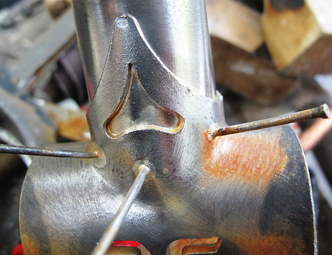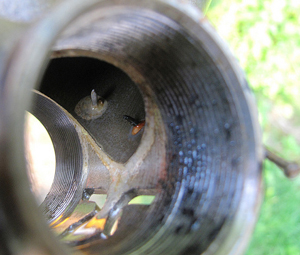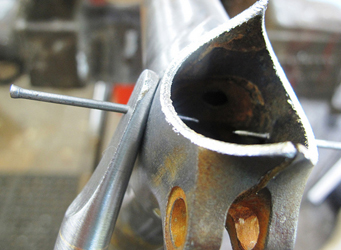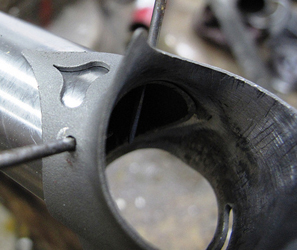Pinning in classic frame building
Posted: Friday 26th June 2020
I sometimes get enquiries from worried owners about the ‘nails’ they have discovered inside their frame tubing. People poke fingers into the tubes for all sorts of reasons, such as looking for reinforcements inside the chainstays hoping to prove that they have Reg Harris’s very own frame! This often results in an involuntary shriek as the finger is withdrawn with blood issuing forth from a deep scratch from the point of the pin.
This process is known as ‘pinning’ and it holds the tubes together while the lugs are brazed, after the tubes have been cut and mitred to a perfect match. I had always assumed that the builders actually used small tacks for this process. I had been unable to find any examples of relevant images from the post-war era but heard that there were some on Richard Sachs Flickr site which he generously allowed us to use to illustrate this piece. Richard is one of the many American builders of classic machines who use the old traditional methods of building combined with some fantastic machinery which would not look out of place in a workshop building spacecraft.
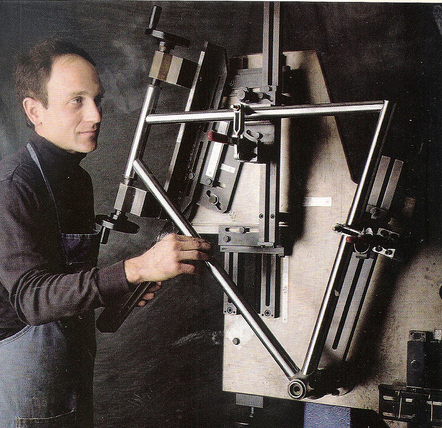
Looking at the images you can see the ‘tack-like’ appearance of the pin, especially inside the bottom bracket. The images of the bottom bracket show the post-brazing state where the pin has become part of the structure. The pin outside the lug is cut and ground down flush with the metal but the inside is left as shown as it would be very tricky to get a grinder inside the bottom bracket. Having said this the inside of the head tube and seat cluster has to be ground flush for obvious reasons. The two lower images show the pins doing their job prior to brazing.
Not all lightweight frames were built by pinning the joints, some builders held the component parts of the frame in a jig whilst brazing. Some of these jigs were very basic, probably constructed by the frame builder himself. Modern day jigs are engineering works of art complete with micro-adjustment at every junction. One of the problems with a jig is to get even heat all around the lug when brazing, some overcame this by having a jig which could be rotated on at least one axis whilst the brazing took place.
Typically, made to measure or bespoke steel bicycle frames are brazed by hand. The frame tubes are held in place with a jig, and the builder heats the joints one at a time with a hand held oxy-acetylene torch. This is the same sort of torch used for welding, but it is used somewhat differently in brazing, since the base metal is not melted.
In the old days, many bicycles were brazed over an open hearth, rather than with a torch. This limited the use of frame building jigs, so that the frame joints had to be pinned or tack-brazed in place before the whole frame could be moved over to the hearth, where one joint after another would be exposed to the heat of the hearth flames. This traditional method remained in widespread usage as recently as the 1970s amongst conservative frame builders, but has largely been superseded by the easier and more precise torch brazing method.
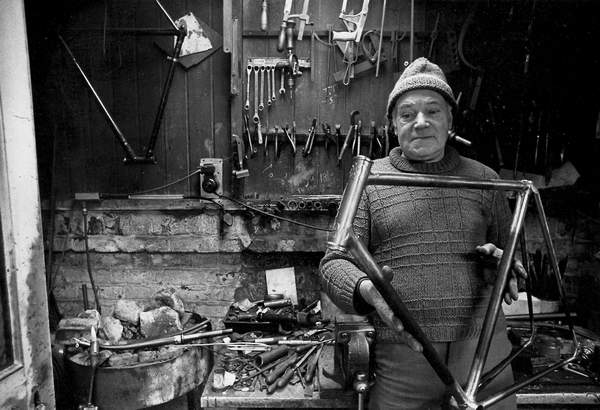
Titch Morris (see above image) was one of the last builders I knew who still used a traditional brazing hearth. Tom Board always used a torch and jig as did Tony Oliver. I am not sure but Titch Morris favoured Reynolds HM tubing whether this has anything to do with him using a brazing hearth I don’t know? He still had some in stock when I last visited his workshop.
Tom Board did not build his frames in a jig – he built freehand from a vice using straight edges to check the alignment. He had a jig that had come from F W Evans which was simply used to get the tube lengths and angles. And he tacked his frames rather than using pins. This combination of methods was very common amongst English framebuilders and is still practised today by a few including Bob Jackson. Some builders use a surface table to check the alignment rather than a straight edge. Hearth brazing is also used at Mercian and was used by Barrie Witcomb until he stopped building quite recently. Pinning is now very rare amongst English framebuilders.
Posted: Friday 26th June 2020
This article appears in the following categories.
Upcoming Events
Whether you are looking for a gentle social meet up, or a 100-mile ride browse the community’s upcoming events and plan your next weekend outing.

